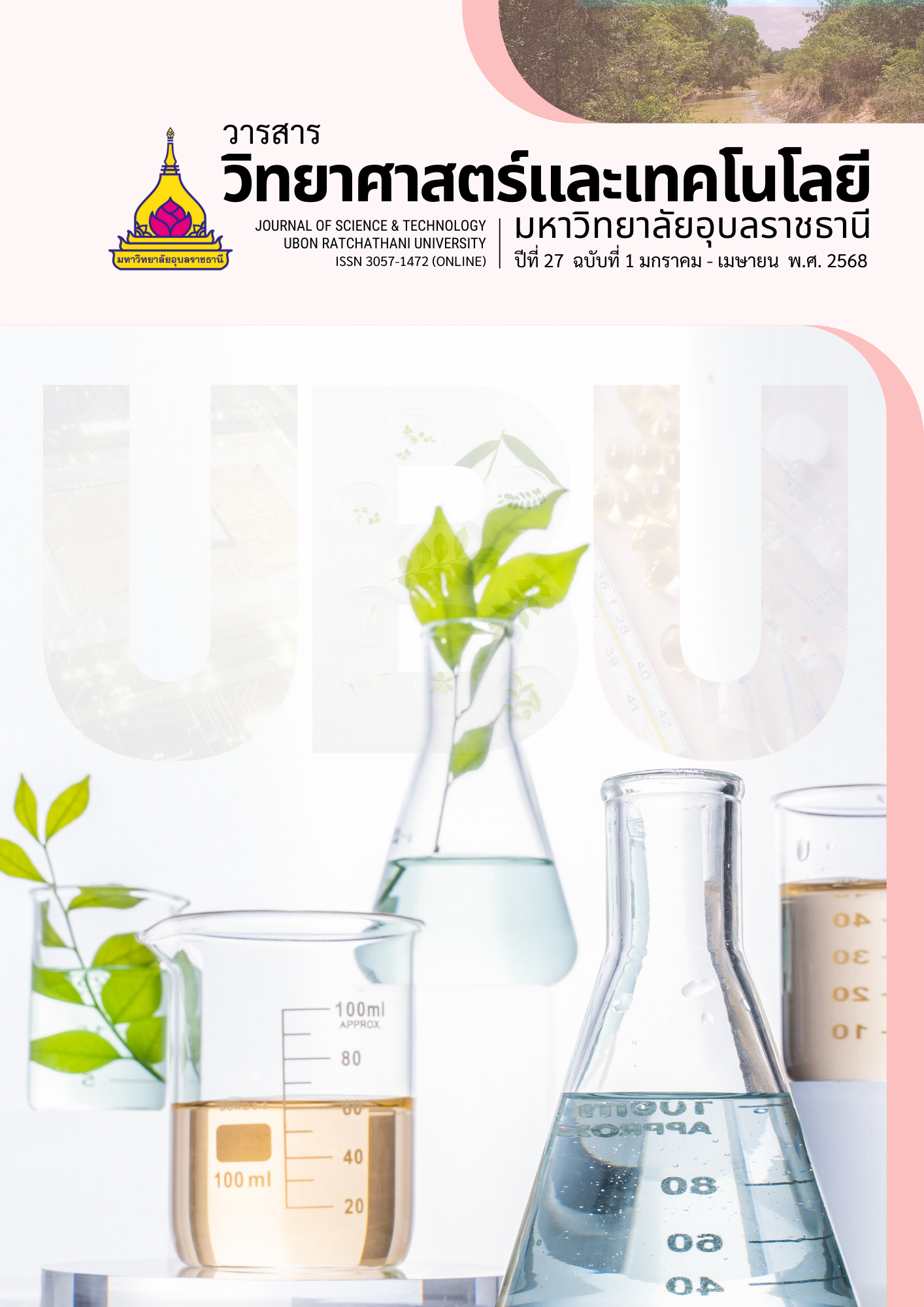Development of Methods for Dyeing Reed Threads with Karanda Dye
Main Article Content
Abstract
Dyeing reed threads with natural dyes is safe for the environment. The ripe fruit of Karanda (Carissa caranda L.) can be used as a natural dye because it is rich in anthocyanin and provides different colors depending on the pH value. This research aimed to develop methods for dyeing reed threads with Karanda dye. The experiment was conducted as a completely randomized design with 3 replicates per treatment. In this study, 3 types of Karanda dye were used including dye 1: the dye without pH adjustment (CM-n), dye 2: the dye which its pH was adjusted with hydrochloric acid and dye 3: the dye which its pH was adjusted with sodium hydroxide. Their pH values were 3.39, 2.61, and 4.10, respectively and their colors were orange-red, red and purplish-red, respectively. In this study, there were 10 treatments including the undyed reed threads (Control), the reed threads dyed without using mordant with dye 1 (CM-n), dye 2 (CM-a) and dye 3 (CM-b); the reed threads dyed using alum as a mordant with dye 1 (M-n-nT), dye 2 (M-a-nT) and dye 3 (M-b-nT); and the reed threads dyed using alum and tannin as mordants with dye 1 (M-n), dye (M-a) and dye 3 (M-b). From the study, it was found that the dyed reed threads in all 9 treatments had brown-red color with different shades and had a* and L* values in the ranges of 22.20-32.80 and 27.95-30.30, respectively. The treatment M-a had the darkest brown-red color with a* and L* values of 24.10 and 25.77, respectively. After the dyed reed threads were kept for 60 days at room temperature, it was found that there was no significant change in a* and L* values for the treatments M-a and M-n. Moreover, the treatment M-a received the highest average satisfaction score of 4.33 from 40 volunteers. This study demonstrated that dyeing reed threads with hydrochloric acid pH adjusted Karanda dye in conjunction with using alum and tannin as mordants could be an alternative for dyeing reed threads with natural dyes.
Article Details

This work is licensed under a Creative Commons Attribution-NonCommercial-NoDerivatives 4.0 International License.
บทความที่ได้รับการตีพิมพ์เป็นลิขสิทธิ์ของ วารสารวิทยาศาสตร์และเทคโนโลยี มหาวิทยาลัยอุบลราชธานี
ข้อความที่ปรากฏในบทความแต่ละเรื่องในวารสารวิชาการเล่มนี้เป็นความคิดเห็นส่วนตัวของผู้เขียนแต่ละท่านไม่เกี่ยวข้องกับมหาวิทยาลัยอุบลราชธานี และคณาจารย์ท่านอื่นๆในมหาวิทยาลัยฯ แต่อย่างใด ความรับผิดชอบองค์ประกอบทั้งหมดของบทความแต่ละเรื่องเป็นของผู้เขียนแต่ละท่าน หากมีความผิดพลาดใดๆ ผู้เขียนแต่ละท่านจะรับผิดชอบบทความของตนเองแต่ผู้เดียว
References
Ardila-Leal, L.D. and et al. 2021. A brief history of colour, the environmental impact of synthetic dyes and removal by using laccases. Molecules. 26(13): 3813.
Adeel, S. and et al. 2019. Environmentally friendly plant-based natural dyes: Extraction methodology and applications. In: Ozturk, M. and Hakeem, K. (eds.) Plant and Human Health. volume 2. Cham: Springer.
Pimchan, P. and Uthaiku, A. 2021. The Process of Dyeing and Coating the Sedge by Natural Materials with a Single Material to Gives Many Color Values for Development the Unique Product. Research Report, Rajabhat Maha Sarakham University. (in Thai)
Pimchan, P. 2019. The Manufacture and Development of Natural Color for Reed Dyeing. Research Report, Rajabhat Maha Sarakham University. (in Thai)
Moonsin, P., Panchari, T. and Sirithip, K. 2021. The study of natural dyes from the Hevea Brasiliensis leaves by using alum, copper sulfate, and ferrous sulfate as a mordant. Journal of Roi Et Rajabhat University: Science and Technology. 2(1): 35-40. (in Thai)
Sueb Nakasateien foundation. 2019. Natural Materials Giving Various Colors. https://shorturl. asia/IkCYB. Accessed 29 September 2023. (in Thai)
Phanhome, P. and Rattanadilok na Phuket, S. 2018. Study on color values and colorfastness of silk dyed with natural dye from yellow poinciana bark. In: Proceedings of the 56th Kasetsart University Academic Conference, 30 January-2 February 2018. Bangkok, Thailand. (in Thai)
Choosakun, J. and Chatkon, A. 2016. The effect of natural mordant pH on shade and quality of dyed silk. In: Proceedings of the National and International Graduate Research Conference 2016, 15 January 2016. Khon Kaen, Thailand. (in Thai)
Boonphan, J., Pankong, I. and Chaimchaiphorn, T. 2019. Anthocyanin extract from natural plants for staining chromosome. In: Proceedings of the 11th National Academic Conference Nakhon Pathom Rajabhat University, 11-12 July 2019. Nakhon Pathom, Thailand. (in Thai)
Xuan, T.L. and et al. 2019. Optimization of total anthocyanin content, stability and antioxidant evaluation of the anthocyanin extract from Vietnamese Carissa Carandas L. fruits. Processes. 7(7): 1-15.
Yurarach, S. 2022. Why Likert? Journal of Innovation and Management. 7(1): 152-165. (in Thai)
Muangthai, P. and et al. 2010. Preparation of color powder dye from mangosteen peel on absorbent. In: Proceeding of the 7th Kasetsart University Kamphaeng Saen Campus Conference, 7-8 December 2010. Nakhon Pathom, Thailand. (in Thai)
Sittikrai, S. and Santhitikawinsakul, A. 2015. The quantitative analysis of anthocyanins from Combretum latifolium dyestuff. In: Proceeding of the 7th NPRU National Academic Conference, 30-31 March 2015. Nakhon Pathom, Thailand. (in Thai)
Pimchan, P. 2015. The enhancing color fastness and color strength of natural pigment for Cyperus Papyrus L. fibril dyeing. Koch Cha Sarn Journal of Science. 37(2): 61-72.
Nammakorn, K., Atorngitjawat, P. and Watcharaporn, K. 2022. Study and development process for reed dyeing with natural dyes using Laccifer lacca Keer. In: Proceeding of the 58th Kasetsart University Annual Conference, 5-7 February 2022. Bangkok, Thailand. (in Thai)
Chaithada, P. 2019. Effect of extraction solvents and pH on the amount of stability of crude color extracted from plants. Wichcha Journal Nakhon Si Thammarat Rajabhat University. 38(1): 65-78. (in Thai)
Jindawuttikul, S. 2019. Staining Reed Lines with Natural Colors. http://lib3.dss.go.th/fulltext/dss_j/2562_68_209_P21-23.pdf. Accessed 29 September 2023. (in Thai)

